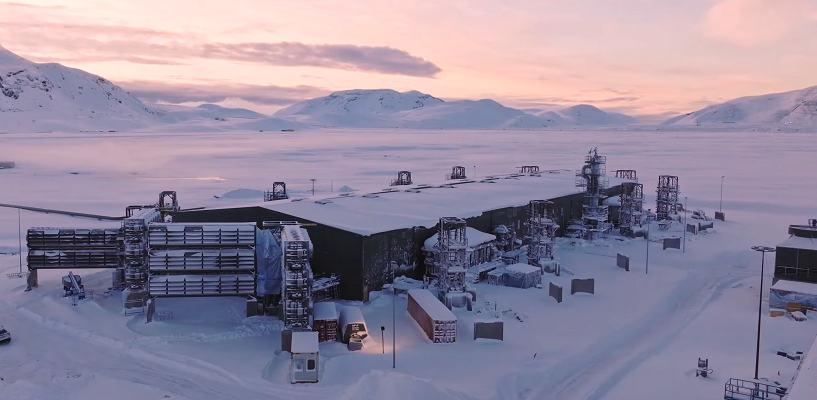Mammoth

| Mammoth | |
|---|---|
| Collector Containers | 72 |
| Nameplate Capacity | 36,000 tons per year |
| Technology | DAC+S |
| Expected adjustment to global warming | 1.5°C above pre-industrial levels |
| Upcoming similar project locations | US (Louisiana), Canada, Norway, Kenya |
When fully operational, its nominal ability to capture CO2 is estimated to be “36,000 tons annually” (order of magnitude greater than its “Orca” counterpart).
Mammoth is the largest and newest “direct air capture and storage” (DAC+S) facility operated by Climeworks. The only DAC+S facility in the world that is open for business is Climeworks. Life cycle emissions at the Climeworks facility are less than 10%.
To help limiting global warming to 1.5 °C above pre-industrial levels, the “Intergovernmental Panel on Climate Change” (IPCC) in recent is clear that gigaton-scale activation of “carbon dioxide removal” (CDR) techniques like “DAC and storage” (DAC+S) is required.
The IPCC and SBTi have identified “direct air capture and storage” (DAC+S) as one of the CDR solutions required to achieve net zero by 2050. ISO 14064-2 validation of the DAC+S technique has been provided by independent “quality and assurance” expert DNV. Climeworks’ initial corporate clients, “Microsoft, Shopify, and Stripe,” receive “third-party” (DNV) validated CDR services (performed at Orca).
The term “net zero” refers to Climateworks’ endeavor to attain that much atmospheric carbon concentration to zero, which is the cause of climate change. With Climeworks, almost 160 “corporate climate leaders” are currently eliminating CO2 from the atmosphere.
Mammoth is not like Orca in that it has two on-site injection wells. The CO2 is piped from Orca to a single Carbfix “injection hole” that is located hundreds of meters distant.
At Mammoth, the captured CO2 is dissolved in water inside the “absorption tower” and then sent to Carbfix for subterranean mineralization. This is not the same as the DAC+S process used at “Orca,” wherein Climeworks supplies “gaseous pure CO2” to Carbfix, which is then dissolved in water subterranean. The supply of “water dissolved CO2” rather than gaseous CO2 reduces the energy demand of Mammoth’s operation.
The U.S. Department of Energy has granted Climeworks, along with the project leader “Battelle” and project collaborator “Heirloom,” a contract worth $50 million to begin the direct air capture (DAC) facility ‘Project Cypress’ in Louisiana. Nearby 2030, when it is completely operational, it is expected to remove “one million tons” of excess carbon dioxide (CO2) annually from the atmosphere.
With its Orca plant in Iceland, which has been in operation since 2021, Climeworks is the first “direct air capture” company in the world to receive certification of its carbon dioxide removal activities under the “Puro Standard” (Puro.earth).
In November 2023, the co-founders and co-CEOs of Climeworks were listed on the first-ever “TIME100 Climate” list.
According to information in April 2023, Climeworks and Partners Group have an “13-year agreement” for Climeworks to remove about 7,000 metric tons of CO2 from the atmosphere, which will be kept underground forever.
As per the data from May 2023, a single corporate buyer and a single CDR company (JPMorgan Chase and Climeworks) will make one of the “largest transactions” in the DAC sector to date. The deal, which is worth more than USD “20 million,” shows the bank’s support for Climeworks’ high-quality, high-integrity strategy, which is focused on the long-term removal of CO2.
A 15-year agreement to remove 80,000 metric tons of carbon dioxide was signed by “Climeworks and BCG,” two years after they originally partnered on “carbon removal” in 2021.
One of the founding members of the recently established “Carbon Removal Alliance” (CRA) is Climeworks. The CRA brings innovators together to promote “policies” that assist a wide range of long-term carbon removal solutions.
Information from March 2024 states that Climeworks and the “LEGO Group” signed a nine-year contract to remove CO2 from the atmosphere permanently. Additionally, KIRKBI inked a long-term contract for USD 405,000 to guarantee Climeworks’ superior “carbon removal services.”
One of Fast Company’s World’s 50 Most Innovative Companies of 2024 is Climeworks. Also, Climeworks was listed as a “Global Cleantech 100 Company and a TIME100 Influential Company” for 2022.
Because Climeworks offers a service in exchange for cash, the purchase of its CDR services is “not tax deductible” as a donation. Although it is not a charitable organization. For more purchase options, visit — “climeworks.com/subscriptions”.
DAC -
Through chemical procedures, “direct air capture” (DAC) technology extracts CO2 from surrounding air. A DAC system typically involves moving huge volumes of natural air through a “filter material” (sorbent) that absorbs CO2 molecules from the air.
Climeworks is an expert in the use of “highly porous solid sorbents with a large surface area” (solid DAC), which adsorbs CO2 molecules. The temperature is raised to about 100°C once the sorbent is “fully loaded” with CO2; at that point, CO2 is expelled from the filter.
To ensure that CO2 is permanently removed, Climeworks gives “gathered pure CO2” to its CO2 storage partner. Climeworks works with “Carbfix,” an expert in subterranean CO2 mineralization. The CO2 is pushed down “deep in underground,” where it interacts with the surrounding basalt to form stone (thus CO2 is removed permanently). In less than two years, CO2 transforms to stone.
Climeworks concentrates on “geological storage” by its effort to send back carbon to the lithosphere. As a result, CO2 spontaneously crystallizes when it reacts with specific minerals, changing from a “gas to a solid material” that forms carbonates.
Because CO2 is dissolved in water prior to underground pushing, there is a very small chance of leakage in the short run. In the long run, there is also a very small “risk of leaking” because CO2 is converted into carbonate minerals.
The amount of atmospheric CO2 that is permanently stored less the “quantity of greenhouse gases released during storage operations and the supply chains that are connected to it” is known as “net removal,” and it is a crucial measure for a carbon dioxide removal (CDR) system. Because there is less CO2 in the atmosphere, DAC+S requires a lot of energy. However, it may be placed where “low-carbon energy and CO2 storage” are both readily available, which can minimize or completely eliminate the requirement for CO2 transport.
The overall efficiency of CO2 removal using DAC+S is dependent on the “energy source” used for the CO2 capture process; the emissions from other processes, such as CO2 transport and injection, are less significant. Because sorbent-based processes run at relatively moderate temperatures — roughly 100°C — they can be used with “solar heat” or renewable energy-powered heat pumps.
The entire “DAC+S process” (including the Carbfix CO2 injection sites) at Mammoth is powered by renewable energy from the Hellisheiði electricity power plant, controlled by ON Power.
Even without water, DAC+S is still a very scalable and space-efficient solution that can be installed on “arid land” and will only cost about 100 €/t CO₂ in the “long run” (in 2050).
*the aforementioned data came from “climeworks.com/uploads/documents/climeworks-industry-snapshot-3.pdf”, “climeworks.com/uploads/documents/2023_09_24_factsheet_about_climeworks_cdr_service.pdf” and “climeworks.com/news/”.
Official Website of Climeworks: https://www.climeworks.com/
That’s all friends.
Ads Section

